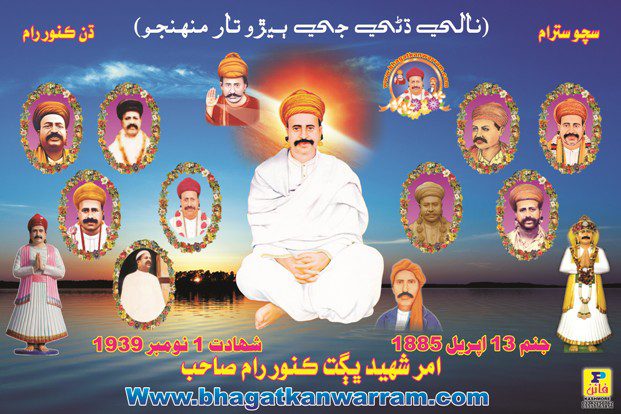Indus Valley – Biography Of Sain Kanwarram

Indus Valley
Indus Valley or Sindhu Desh Civilization is the oldest civilization on the earth. Mohan-Jo-Daro stands as a witness, monument, and edifice to this great culture and civilization, dating back to more than five thousand years. Mohan-Jo-Daro reveals a full-fledged, most advanced civilization with well-planned city, complete with modern sewage system etc. In ‘Regveda’ it is clearly mentioned – “O’ Sindhu, people on your banks knew how to weave clothes from cotton and silk fibres”. It means when earth was barren and the people were naked even then culture of this valley was so developed.
On the banks of sacred river, Indus (Sindhu) the great Rishis heard to the voice of God in the form of Vedas. In reality, the Vedas are not supposed to be in written form. The Vedic Mantras or Slokas are supposed to be recited and remembered from generation to generation in the descending order, as the proper pronunciation of each Sanskrit word is very important. If the pronunciation is distorting, the divine power, potency, and effect of the word and Mantra is lessened, modified, minimized, or even neutralized to zero. In the praise of holy river Sindhu the following hymn from Rigveda mentions:-
1. The Singer, Oye waters, in vivasvan’s place, shall tell your grandeur forth that is beyond compare. The rivers have come forward triply, seven and seven. Sindhu is might surpass all the streams that flow.
2. Varuna cut the channels for thy forward course. O’ Sindhu, when thou rankest on to win the race. Thou speediest over precipitous ridges for the earth, when thou art Lord and Leader of these moving floods.
3. His roar is lifted up to heaven above the earth; he puts forth endless vigor with a flash of light. Like floods of rain that fall in thunder from the cloud, so Sindhu rushes on bellowing like a bull.
4. Like mothers to their calves, like munchkin with their milk, so Sindhu, unto thee the roaring rivers run. Thou leaded as a warrior king thine army’s wings what time thou comest in the van of these swift streams.
5. Favor ye this my land, O’ Ganga, Yamuna, O’ Sutudvi, Parushni and Sarasvati with Asikni, Vitasata, O’ Marudvirdha, O’ Arjikya with Sushana hear my call.
6. First with Trishtama thou art eager to flow forth with Rosa and Susartu and with Svetya here, with Kubha and with these, Sindhu! and Mehantnu, thou seekest in thy course Krumu and Gomati.
7. Flashing and whitely – gleaming in her mightiness, she moves along her ample volume through the realms, most active of the active Sindhu unrestrained, like to a dappled mare, beautiful fare to see.
8. Rich in good steeds is Sindhu, rich in cars and robes, rich in gold, nobly fashioned, rich in ample wealth. Blest Silamavati and Youngurnavati invest themselves with raiment rich in store of sweets.
9. Sindhu hath yoked a car, light rolling, drawn by steeds and with that car shall see win booty in this fight. So have I praised its power, mighty and unrestrained of independent glory, roaring as it runs?
(The Hymns of Rigveda Book-X, Hymn-LXXV Ralph T.H. Griffith, Vol. II, 3rd edition, 1926 published by Benares, E.J. Lazarus & Co.)
These are very important Hymns and in the praise of sacred river Sindhu. These depict elaborate and relate the glory and grandeur of great river Sindhu. I would like to explain the meaning of the above Hymns for the understanding and good of the readers otherwise it would just difficult and dry reading.
1. Oye waters: apparently the rivers are addressed as representing all the divine waters.
2. Viva Svan’s place where the singers stand when they sing Hymns.
3. Triply, seven and seven; twenty-one rivers; two other sets of seven each being added to seven, chief rivers of the Punjab. Sayana explains differently – ‘they flowed by sevens through the three (worlds)’ – Wilson. ‘Each set of seven streams has followed a three fold course Muir.’ ‘By seven and seven……. in three courses – Max Muller. Yamuna-Jamuna, Satudri; the Sutlej or Sat Jay Parushini; the Ravi : Asikni: the ancient Acesines: the Vedic name of the Chandrabhaga, the present Chenab river. Vitasta: probably the Jhelum, the Hydaspes of the Greeks. Marudvirdha: meaning increased by the Maruts not identified. Arjikya and Sushoma are by the Yaska to be the Vipas and the Sindhu: but this is not possible and it is uncertain what rivers are meant. Kabha Krumu and Gomati are the names of rivers Silamavati and Urnavati appear to be the names of rivers. According to Sayana the words are epithets of Sindhu and mean respectively, a bounding in ‘Silama’ plants said to be used for cordage and rich in wool. Due to abundance Sindhu water and wonderful soil the Cotton of Sindh was famous and the cloth of Sindhu was exported out to Indonesia, Java, Sumatra and Babylon and to for off countries through the Arabian Sea. The Sindh was also called as “Sawasa” which means the greatest cloth producing country. The bed sheets, ‘Chadars’ of Nasarpur were very famous. A fine ‘Chadar’ of Nasarpur also presented to Alexander-the- great. It is said that the burial cloth known as ‘Holy Shroud of Christ’ was imported from Sindh. The great Hindu warrior Raja Dabarsen ruled the great and scared land of Sindh was but unfortunately Mohd. Bin Qasim defeated him and that was the darkest day in the history of Sindh that Islam entered and spread in the nook and corner of the pious and holy land of Vedas. The word ‘India’ is also derived from ‘Indus’ and word ‘Hindu’ also comes from ‘Sindhu’.
